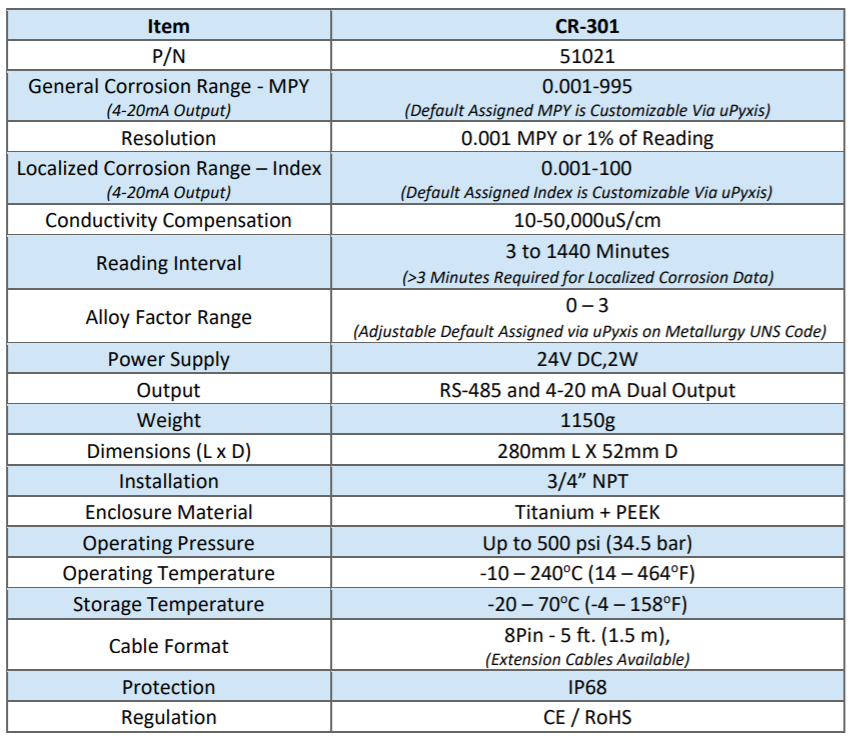
Pyxis CR 301
- Product Details
- Features
- Specifications
- Video
- LPR vs. Coupons
CR-301 High Temperature & Pressure Corrosion Rate Sensor
- Ultra-Low General Corrosion Rate Detection down to 0.001 MPY
- Titanium/PEEK Liquid End
- Integrated Cooling Fins
The Pyxis CR-301 corrosion rate sensor is ideal for extreme environmental and sample conditions in process application monitoring where robustness and affordability are a must. The sensor utilizes the linear polarization resistance (LPR) method to produce a raw signal. The raw signal is conditioned, amplified, and digitized directly in the sensor itself. This avoids the interferences and attenuation of the raw signal caused by long-distance wiring needed for other corrosion probes to a separate signal conditioner or transmitter box.
The Pyxis CR-301 corrosion sensor measure sample water conductivity directly and compensate for the conductivity impact on the LPR measurement. These unique product characteristics make the Pyxis LPR superior in performance and accuracy. In addition to the LPR measurement to obtain the general corrosion rate, the CR-301 sensor also measures electrochemical noise. The measured noise data is used to calculate an index to quantify the localized corrosion rate also referred to as pitting.
Typical Applications
- High Temperature / High Pressure Applications
- Geothermal – Process
- District Energy – Heating
- Oil & Gas – Process / Produced Water
CR-301 High Temperature & Pressure Corrosion Rate Sensor
- Anti-electromagnetic Interference (anti-EMI) design with Titanium sensor body
- 2x 4–20mA Outputs (General Corrosion and Localized Corrosion)
- RS-485 Modbus Output
- Integrated Cooling Fin Design for High Temperature Applications
- Bluetooth Connectivity to uPyxis® app when used with MA-CR Adapter
- Default 4-20mA Output scales and Alloy Factors assigned for selected metallurgy via uPyxis®
- Customization of Alloy Factor and upper MPY / Index (20mA) scale as desired via uPyxis®
- Ultra-Low General Corrosion Rate Detection down to 0.001 MPY
The CR-301is a standalone high temperature and high pressure rated LPR corrosion sensor that can be powered by a 24 VDC power source such as an existing controller, PLC or DCS. The sensor is composed of Titanium and PEEK (Polyether Ether Ketone) making it highly resilient to extreme process environments, temperatures and pressures. The CR-301 also offers an expanded general corrosion range as high as 995 mils per year and localized corrosion index as high as 100.
When used with the provided MA-CR Pyxis Bluetooth Adapter, the CR-301 must be configured via the uPyxis APP for Mobile or Desktop devices. The uPyxis app is used to configure the CR-301 for the metallurgy desired, assign a sensor identification name, obtain live sensor readings. Default measurement ranges and alloy factors will be applied to the CR-301 via the uPyxis APP when the user selects the metallurgy desired. Custom alloy factors and ranges of measurement may be adjusted if desired. Additional diagnostic information is available and can be used for determining the sensor performance or the need for maintenance.
CR-301 High Temperature & Pressure Corrosion Rate Sensor

LPR Corrosion Sensors -vs- Corrosion Coupons
The use of the LPR corrosion rate represents a valuable tool that can be easily and affordably deployed to provide both general and localized corrosion measurements in an instantaneous format. There is a common industrial misnomer that the use of inline LPR corrosion sensors should be identical to that of corrosion coupons. The LPR corrosion level represents the real-time electrochemical measurement of corrosion. While it may be linear with respect to the corrosion rate obtained from the weight loss of a coupon exposed to water for a long period, the LPR corrosion rate may not necessarily be the same exact value of the latter. The instantaneous nature of the device general corrosion measurement represents a “real-time condition” on a Mils-Per-Year (MPY) scale (1 Mil = 1/1,000 inch) based on the specific metallurgy being assessed and will in many cases vary, in a short time scale, from a corrosion coupon. The LPR data should be used to best understand the linear relationship with coupons and for real-time application performance assessment and adjustment.



